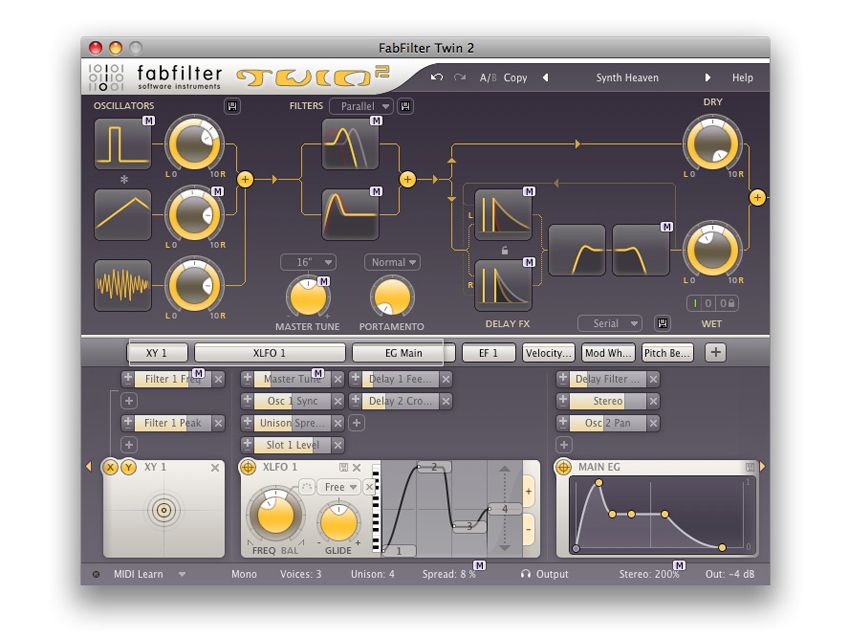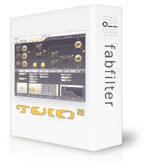

- #REAPER FABFILTER TWIN 2 SETUP HOW TO#
- #REAPER FABFILTER TWIN 2 SETUP PRO#
- #REAPER FABFILTER TWIN 2 SETUP PLUS#
Use your ears to determine the release time that sounds appropriate for your mix.

I like to start with a fast release time, and then increase the release time of my compressor until my kick is clear, punchy, and present. To create creative pumping effects that draw attention to themselves, use a slow release time. For a transparent form of compression, use a fast release time this is useful if you’re just trying to get the “click” of a kick to punch through your mix. The release time you should use depends on the effect you’re in pursuit of. You’re going to want to use a fast attack time (1-10 ms) to attenuate your bass as soon as your kick plays the faster you set the attack time, the faster the bass will duck out of the way. To start, disengage Auto Gain so that you’re able to make accurate A/B comparisons when you bypass the compressor. There are a few settings you should tweak to get the most out of your sidechain compressor. If you’re trying to prevent your bass from masking your kick, apply the compressor to your bass track.įigure 4: The "Ext" button within the sidechain section of FabFilter's Pro-C 2. Set Up an External InputĪpply a compressor like the FabFilter Pro-C 2 to the track that you want to apply gain reduction to.
#REAPER FABFILTER TWIN 2 SETUP PRO#
If you're using Cubase, Logic Pro, or Pro Tools, you can use this guide to set up an external input once you've done this, skip ahead to Step 2. In Ableton, it’s a rather straightforward 3-step process that's quite similar to how you would apply sidechain compression using stock Ableton effects. The way you go about routing audio into the FabFilter Pro C-2's external sidechain input will vary slightly depending on the DAW you’re using.
#REAPER FABFILTER TWIN 2 SETUP HOW TO#
How to Set Up FabFilter's Pro-C 2 to Apply Sidechain Compression Just like a compressor being used normally, a compressor responding to an external sidechain input signal will still compress the track you applied the compressor to. To be clear, compression is not applied to the sidechain input signal. When a compressor has its sidechain circuit engaged, the sidechain input signal trigger’s the compressor. If you apply a compressor to your bass track and set your kick track as the compressor’s sidechain input signal, the compressor will apply gain reduction to the bass track every time the kick plays.ĭon’t overthink this concept it’s as simple as it sounds. When you engage a compressor’s sidechain circuit and select another track in your DAW as the sidechain input signal, you tell the compressor to respond to the signal level of the other track, as opposed to the signal level of the track the compressor has been applied to. For example, if you apply a compressor to a vocal track, it will attenuate the level of the vocal when it gets too loud. Sidechain Compression ExplainedĪ compressor normally responds to the signal level of the track you’ve applied it to. If you’re a red-blooded synth fanatic, Twin 3 makes for a must-have addition to your virtual instrument arsenal.New to the concept of compression? Get started with "The Ultimate Guide to Compression" to learn how a compressor works and discover the best compressors for music production and post-production work.

Of course, you also get FabFilter’s acclaimed fine-tuned knobs and controllers, interactive MIDI Learn, an undo/redo and A/B switch, Smart Parameter Interpolation, sample-accurate automation, interactive help hints, NEON and SSE optimization, and a whole lot more. Moreover, Twin 3’s oscillator and filter sound quality has received a significant sonic upgrade, along with built-in analog-modeled drift. This comprehensively redesigned 64-voice soft synth vaunts an easier workflow than its predecessor, with a simplified interface, a new design of modulation sources, and a floating slot panel and FX panels.
#REAPER FABFILTER TWIN 2 SETUP PLUS#
Twin 3 brims with powerful features, including four ultra-flexible oscillators, four filters, six FX modules, and effortless drag-and-drop routing, plus a vast modulation system with a multitude of source signal generators and limitless modulation assignments. Twin 3 isn’t a mere polyphonic synthesizer plug-in it’s your one-way ticket to modulation nirvana.


 0 kommentar(er)
0 kommentar(er)
